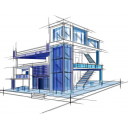- myjianzhu

- 樓主
孟買新2號(hào)航站樓/Chhatrapati Shivaji International Airport – Terminal 2 SOM

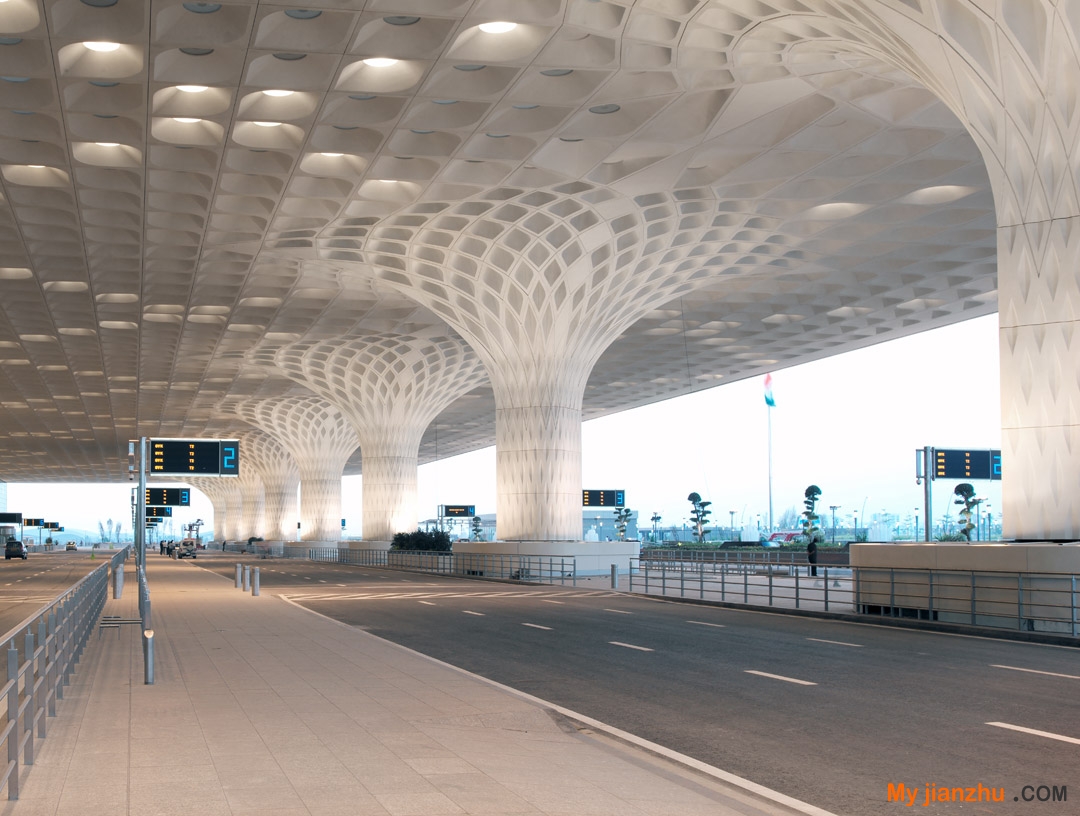
作為中國(guó)的近鄰,人口數(shù)量同樣龐大的印度在全球化道路上也步履不停的向前發(fā)展。SOM設(shè)計(jì)的孟買新2號(hào)航站樓在此契機(jī)下拔地而起,在現(xiàn)代化的環(huán)境和設(shè)施中,展示出孟買與印度的歷史與傳統(tǒng)。
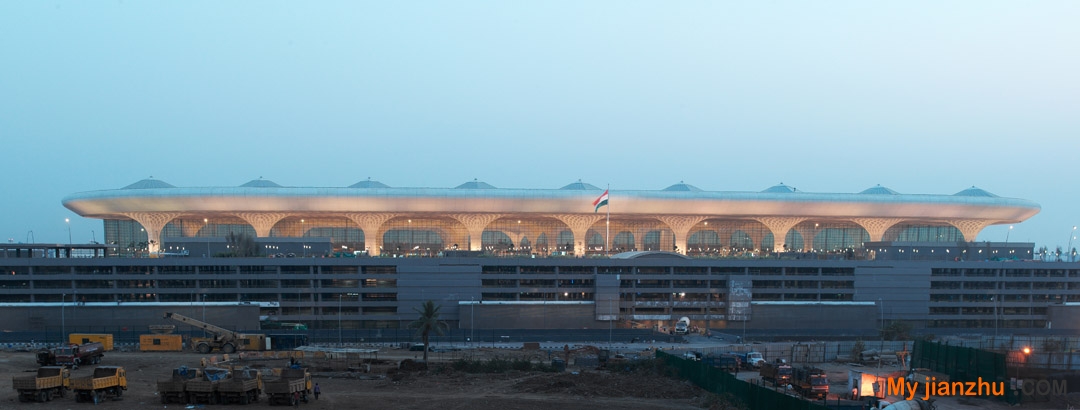


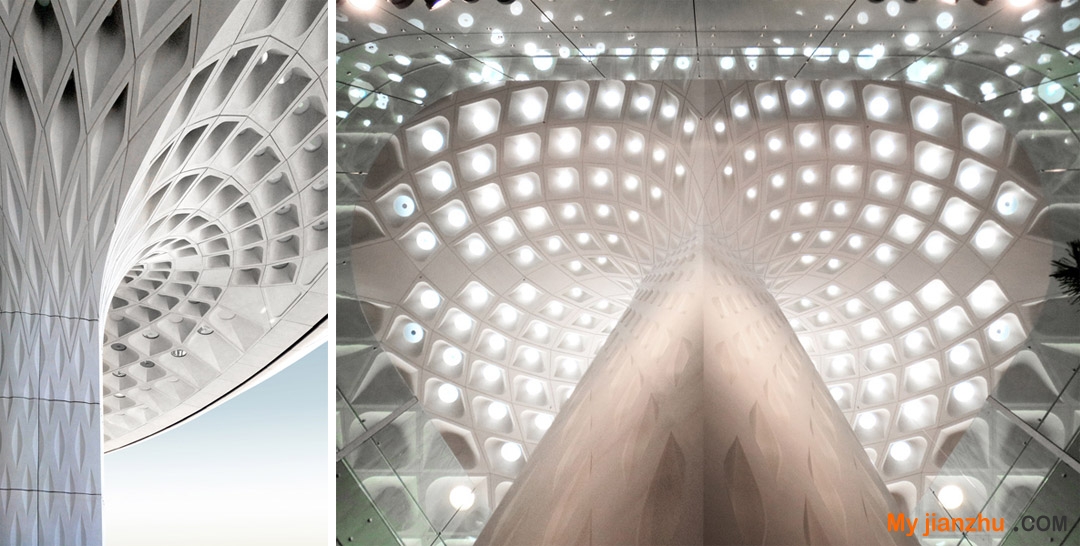
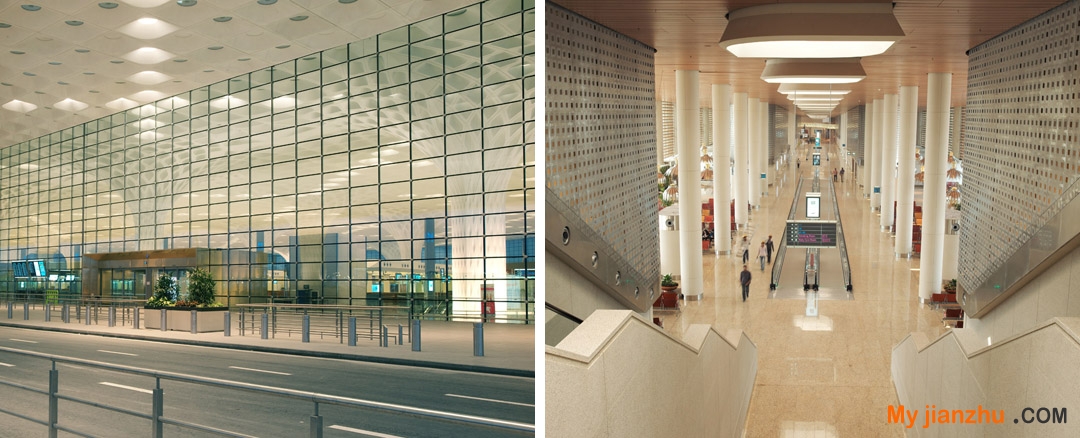



十年前,在孟買的賈特拉帕蒂·希瓦吉國(guó)際機(jī)場(chǎng)起落的旅客每年有6百萬人。而如今,人數(shù)幾乎是十年前的5倍。逐漸崛起的孟買成為印度的商業(yè)首都,國(guó)家的快速發(fā)展和因經(jīng)濟(jì)流動(dòng)的中產(chǎn)階級(jí),使機(jī)場(chǎng)的基礎(chǔ)設(shè)施無法承受不斷增長(zhǎng)的國(guó)內(nèi)、國(guó)際運(yùn)輸,導(dǎo)致航班常常晚點(diǎn)。設(shè)計(jì)融合了復(fù)雜的旅客飛機(jī)網(wǎng),并能適應(yīng)該地區(qū)飛速發(fā)展,機(jī)場(chǎng)的2號(hào)航站樓拔地而起,維護(hù)著其作為通往印度的大門的榮耀。
賈特拉帕蒂·希瓦吉國(guó)際機(jī)場(chǎng)為2號(hào)航站樓新開辟了440萬平方英尺的土地,24小時(shí)全天候運(yùn)營(yíng),每年的旅客吞吐量可達(dá)4000萬。該航站樓將國(guó)際客運(yùn)服務(wù)與國(guó)內(nèi)客運(yùn)服務(wù)合并在一起,提高了航站樓的運(yùn)營(yíng)效率,也縮短了旅客的步行距離。受印度傳統(tǒng)樓閣形態(tài)的啟發(fā),這座4層的航站樓建有一個(gè)宏偉的“頂樓”,或者說是中央處理平臺(tái),下面則是用途廣泛、設(shè)施齊全的大廳。這些大廳并非互相分隔,而是從中央處理核心向外輻射,從而可以在國(guó)際航班與國(guó)內(nèi)航班之間自由穿梭。
Ten years ago, Mumbai’s Chhatrapati Shivaji International Airport welcomed six million passengers per year through its gates; today it serves nearly five times that number. With the city’s emergence as India’s financial capital and the country’s rapidly expanding and economically mobile middle class, the existing airport infrastructure proved unable to support the growing volume of domestic and global traffic, resulting in frequent delays. By orchestrating the complex web of passengers and planes into a design that feels intuitive and responds to the region’s rocketing growth, the new Terminal 2 asserts the airport’s place as a preeminent gateway to India.
Chhatrapati Shivaji International Airport Terminal 2 adds 4.4 million square feet of new space to accommodate 40 million passengers per year, operating 24 hours a day. The terminal combines international and domestic passenger services under one roof, optimizing terminal operations and reducing passenger walking distances. Inspired by the form of traditional Indian pavilions, the new four-story terminal stacks a grand “headhouse,” or central processing podium, on top of highly adaptable and modular concourses below. Rather than compartmentalizing terminal functions, all concourses radiate outwards from a central processing core and are therefore easily reconfigured to “swing” between serving domestic flights or international flights.
航站樓不僅是孟買新的高科技標(biāo)志,其結(jié)構(gòu)也融合了當(dāng)?shù)氐牡乩憝h(huán)境、歷史和文化。優(yōu)雅的路邊送客區(qū)專為大批送別的祝福祈禱者設(shè)計(jì),滿足了印度舉行歡迎和送別儀式的傳統(tǒng)需要。區(qū)域格局和結(jié)構(gòu)同整個(gè)航站樓完美的融于一體,從頂樓圓柱和頂部表面的鉸接式花格鑲板到讓陽光如星輝般灑滿大廳的格子窗,2號(hào)航站樓從現(xiàn)代化機(jī)場(chǎng)的角度重新審視傳統(tǒng)。
But just as the terminal celebrates a new global, high-tech identity for Mumbai, the structure is imbued with responses to the local setting, history, and culture. Gracious curbside drop-off zones designed for large parties of accompanying well-wishers accommodate traditional Indian arrival and departure ceremonies. Regional patterns and textures are subtly integrated into the terminal’s architecture at all scales. From the articulated coffered treatment on the headhouse columns and roof surfaces to the intricate jali window screens that filter dappled light into the concourses, Terminal 2 demonstrates the potential for a modern airport to view tradition anew.
機(jī)場(chǎng)所處的優(yōu)越的地理位置決定了它在城市中的牢固地位,而孟買也正在經(jīng)歷著快速的發(fā)展和改造。2號(hào)航站樓則是這場(chǎng)復(fù)興中意義非凡的一筆,成了周邊地區(qū)的堅(jiān)實(shí)支柱和地標(biāo)。通過融入現(xiàn)有交通結(jié)構(gòu)、借助與新公路網(wǎng)同時(shí)發(fā)展以加深交通聯(lián)系, 2號(hào)航站樓將孟買的中心與南部聯(lián)系在一起,同時(shí)孟買的城市邊緣線也在不斷向東部和南部蔓延。另有計(jì)劃在2號(hào)航站樓口修建地鐵,為這座發(fā)展中城市提供更為便利的交通。
The prominent location of the airport within the city of Mumbai bestows it with a strong presence within a portion of the city that is experiencing rapid growth and redevelopment. Terminal 2 is a significant part of this renaissance as an infrastructural anchor for the neighborhood, and as a landmark within the surrounding community. By integrating into the existing transportation fabric and by furthering connectivity through the simultaneous development of a new road network to service the airport, the terminal helps knit together the historic heart of Mumbai to the south with the city’s burgeoning peripheries to the east and north. Plans are also in place for the construction of an underground metro station at the terminal’s entrance, providing further connectivity to the growing city.
國(guó)內(nèi)外旅客都要從一條高架路進(jìn)入航站樓四層的候機(jī)廳。在入口處道路就分叉了,給需要舉行送別禮的人留出足夠的空間。從游客踏入航站樓的第一刻起,航站樓便會(huì)為旅客提供貼心的服務(wù)。頂層的候機(jī)廳連接著所有的車道口,保護(hù)旅客和游人免受孟買高溫以及不預(yù)期的季風(fēng)氣候的影響。航站樓的玻璃斜拉墻是世界上最高的,足有50英尺,與檢票大廳聯(lián)通。根據(jù)印度航天管理?xiàng)l例,非旅客不能進(jìn)入航站樓,透明的建筑物外觀可以讓他們目送著朋友親人離開。
進(jìn)入航站樓,旅客便進(jìn)入了一個(gè)溫暖、明亮的空間,一列多層圓柱支撐著大跨度屋頂,屋頂下30個(gè)高大的柱子打造的巨大空間使人們想起傳統(tǒng)地域性建筑中的空中閣樓和內(nèi)部庭院。陽光透過鑲嵌在頂棚花格鑲板上的彩色玻璃,點(diǎn)點(diǎn)綽綽的灑在大廳里,那斑斕的色彩讓人們聯(lián)想起機(jī)場(chǎng)的標(biāo)志,也是印度的國(guó)鳥——孔雀。
All international and domestic passengers enter the terminal headhouse on the fourth floor, accessed from a sweeping elevated road. At the entrance, the lanes split, making room for wide drop-off curbs with ample space for departure rituals. From the moment of arrival, the terminal embraces travelers. Above, the headhouse roof extends to cover the entire arrivals roadway, protecting passengers and their guests from Mumbai’s heat and unpredictable monsoon weather. A 50-foot-tall glass cable-stayed wall—the longest in the world—opens to the soaring space of the check-in hall. The transparent fa?ade also allows accompanying well-wishers, who must remain outside of the terminal due to Indian aviation regulations, to watch as their friends and family depart.Once inside, travelers enter a warm, light-filled chamber, sheltered underneath a long-span roof supported by an array of multi-story columns. The monumental spaces created beneath the thirty mushrooming columns call to mind the airy pavilions and interior courtyards of traditional regional architecture. Small disks of colorful glass recessed within the canopy’s coffers speckle the hall below with light. The constellation of colors makes reference to the peacock, the national bird of India, and the symbol of the airport.
檢票廳通往一個(gè)零售中心,在這里旅客可以購(gòu)物、吃飯、從大大的落地窗看飛機(jī)起飛。這些商店位于大廳和航站樓中心的交匯處,靠近登機(jī)門,是最熱鬧的地方。它們以及整個(gè)大廳的設(shè)備和細(xì)節(jié)處都彰顯了文化的氣息,比如以荷花為靈感的定制枝形吊燈以及當(dāng)?shù)厮囆g(shù)家制作的傳統(tǒng)的馬賽克鏡子使旅客能感受到機(jī)場(chǎng)外的社會(huì)和文化。地域性藝術(shù)品和手工制品陳列在中央的多層藝術(shù)墻上,被透過天窗進(jìn)來的陽光照亮。藝術(shù)和文化的流行加上暖色調(diào)和優(yōu)雅風(fēng)格的使用,提升了航站樓的氛圍,擺脫了那種典型而無趣的飛機(jī)場(chǎng)形象。
盡管航站樓有四層,但是相連的燈槽和多層采光井確保光線可以照進(jìn)較低的樓層,就像在不斷地提醒周圍的城市和風(fēng)景注意自己的存在。黃昏時(shí)分,航站樓的里面亮了起來,就像一個(gè)吊燈雕塑。
The check-in hall leads to a retail hub—a common space that allows passengers to shop, eat, and watch planes take off though expansive, floor-to-ceiling windows. Centrally located at the junction of the concourses and the terminal core, these commercial plazas provide a focal point of activity in close proximity to the gates. Within these spaces and throughout the concourses, culturally referential fixtures and details, such as custom chandeliers inspired by the lotus flower and traditional mirror mosaic work created by local artists, ground the traveler to a community and culture beyond the airport. Regional artwork and artifacts are displayed on a central, multi-story Art Wall, illuminated by skylights above. The prevalence of local art and culture, coupled with the use of warm colors and elegant accents, elevates the ambience of terminal beyond the typical, often unimaginative airport experience.
Although the terminal is four stories, interconnecting light slots and multi-story light wells ensure that light penetrates into the lower floors of the building, acting as a constant reminder of the surrounding city and landscape. At dusk, illuminated from within, the terminal glows like a sculpted chandelier.
新航站樓的施工場(chǎng)地與原來的航站樓靠的很近,施工期間原航站樓仍需全面運(yùn)轉(zhuǎn)。對(duì)地點(diǎn)的要求引發(fā)了延長(zhǎng) 新航站樓X 型計(jì)劃的構(gòu)想,這樣既能融于現(xiàn)有結(jié)構(gòu),還能運(yùn)用模塊化設(shè)計(jì)滿足快速的階段性建設(shè)。這種創(chuàng)新形式方便重要旅客解決手續(xù)辦理、行李搬運(yùn)以及零售/就餐問題。每一層都有輻射型的通道,指引著從航站樓中心到登機(jī)區(qū)的最短路程,同時(shí)最大限度的增加了航站樓的周長(zhǎng)以保證登機(jī)門的數(shù)量。航站樓樓頂是世界上最大的沒有伸縮縫的屋頂之一,以確保航站樓具備更高的靈活性。鋼桁架結(jié)構(gòu)跨度性強(qiáng),能讓那30根40米高的圓柱保持足夠的距離,不僅讓手續(xù)辦理區(qū)顯得很開闊,還為票務(wù)處和其他必要辦公設(shè)施的排布提供了最高的靈活性。
The construction site of the new terminal building was located in close proximity to the existing terminal which had to remain fully operational during construction. This site requirement inspired the elongated X-shape plan of the terminal, which could both mold around existing structures and incorporate modular designs to accommodate rapid and phased construction.
This innovative form also allows for the consolidation of important passenger processing, baggage handling, and retail/dining functions at the center of the terminal. On each floor, radiating piers permit the shortest possible walking distances from the center of the terminal to boarding areas, while also maximizing the terminal’s perimeter for aircraft gates.
The terminal’s roof—one of the largest in the world without an expansion joint—ensures further terminal flexibility. The long-span capabilities of the steel truss structure allow for the spacing of the thirty 40-meter columns to be far enough apart to not only give a feeling of openness to the large processing areas below but also to allow for maximum flexibility in the arrangement of ticket counters and other necessary processing facilities.
2號(hào)航站樓采用高性能的玻璃裝配系統(tǒng),通過定制的玻璃熔塊模型優(yōu)化最佳熱力性能,減少眩光。航站樓幕墻上的帶孔金屬面板可以過濾日出后和日落前的陽光,盡可能為候機(jī)的旅客營(yíng)造出舒適的日光照明空間,靈敏的日光控制了室內(nèi)外光線亮度的平衡,以實(shí)現(xiàn)節(jié)能的目的。登記大廳通過天窗采光能幫助航站樓減少23%的能耗.
2號(hào)航站樓還采用了現(xiàn)代化材料和技術(shù)來增強(qiáng)效果。但是,盡管先進(jìn)的策略為可持續(xù)的現(xiàn)代化機(jī)場(chǎng)設(shè)計(jì)設(shè)立了新的標(biāo)準(zhǔn),這個(gè)航站樓仍然展示出了孟買和印度的歷史與傳統(tǒng),因?yàn)樗诮Y(jié)構(gòu)和科技方面取得了巨大成就。賈特拉帕蒂-希瓦吉國(guó)際機(jī)場(chǎng)從孟買的秀麗風(fēng)景中拔地而起,不僅體現(xiàn)了印度深厚的文化傳統(tǒng),還見證了印度持續(xù)加強(qiáng)全球化的愿景。
Terminal 2 uses a high-performance glazing system with a custom frit pattern to achieve optimal thermal performance and mitigate glare. Perforated metal panels on the terminal’s curtain wall filter the low western and eastern sun angles, creating a comfortable day-lit space for waiting passengers, and responsive daylight controls balance outdoor and indoor light levels for optimal energy savings. Strategically-placed skylights throughout the check-in hall will reduce the terminal’s energy usage by 23%.
At Terminal 2, modern materials and technologies are used to powerful effect. But while cutting-edge strategies set a new standard for sustainable, modern airport design, the terminal is as much a showpiece of the history and traditions of India and Mumbai as it is an unprecedented structural and technological achievement. Rising from the Mumbai cityscape, Chhatrapati Shivaji International Airport celebrates both India’s rich cultural heritage and the country’s increasingly global future.


